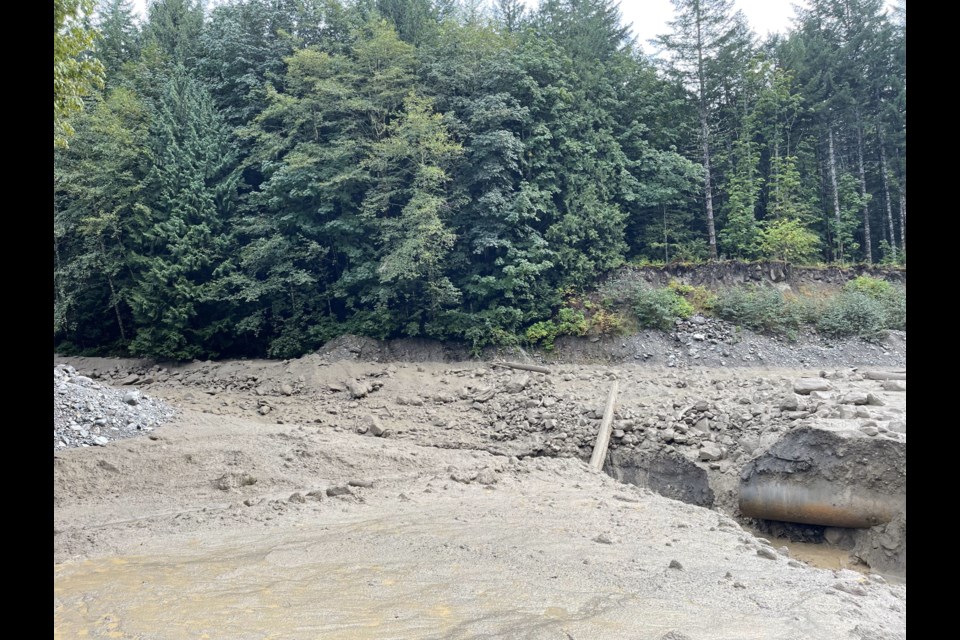What started as a peaceful day surrounded by nature quickly became a fight to get home.
Last weekend, dozens of campers in the 樱桃视频Valley were stranded when a bridge on the 樱桃视频River Forest Service Road washed out, leaving more than 20 vehicles stranded in the remote backcountry.
In an email to The 樱桃视频, the Ministry of Forests said that excavators have since restored some access, allowing vehicles to be removed.
However, the 樱桃视频River Forest Service Road remains closed as repairs are set to begin.
The ministry said that work could start as early as today, Sept. 19.
“The crossing is prone to debris torrents from Mout Cayley, and the Ministry urges travellers to heed posted warnings and be prepared for potential hazards. The province is also working to improve public access to road conditions and strengthen maintenance records for Forest Service Roads,” a spokesperson for the ministry said.
"We continue to explore permanent solutions to this issue within the difficult terrain," the ministry stated in an email to The 樱桃视频. "We urge people who use forest service roads to be prepared before heading into the backcountry."
Among those affected by the 樱桃视频Valley washout were May Zadnipryany and her husband Oleg who found themselves and others trapped after the washout severed the only road access.
A sudden and shocking discovery
The Zadnipryanys had set out on a quick day trip on Sept. 14 to enjoy the natural beauty of the area.
"We passed over the creek or bridge just a couple of hours earlier," May Zadnipryany said.
"After that, we had a quick lunch and started heading back to Vancouver. For some reason, three cars ahead of us stopped. We wondered what was going on because they were just standing in the middle of the road."
Curious, they pulled over.
"I saw that there was a muddy circle on the road. That’s when we realized the road had split in half because of the washout," she said. "All we could see were two pipes, and the gravel that was on top of them had been washed away by the river."
Similarly, Adam Smolcic arrived at the scene after camping.
"Someone came in and told all the campers that the bridge had washed out. We slowly made our way down there, and when we arrived, there were probably 20 people gathered. The water was rushing violently—it was loud, and everyone was in shock," he said.
Stranded without assistance
With no cell reception and no immediate help on the way, the stranded campers faced growing concerns. "We waited there for two and a half hours, hoping someone would come to help us," Zadnipryany said. "But after four hours, no one showed up."
Smolcic noted that those with satellite communication devices sent out SOS messages. "That gave us a sense of security that help would eventually come," he said.
However, the challenging terrain made immediate rescue difficult. "There was no way to cross. The water was still rushing, and the mud was still flowing, so it wasn’t safe."
Taking matters into their own hands
As hours passed without assistance, some stranded campers decided to take matters into their own hands.
"A young man decided to try crossing the debris field, and we saw him make it to the other side, though he was covered in mud," Zadnipryany said.
Realizing they might be on their own, the Zadnipryanys decided to attempt the crossing.
"I told my husband, 'If that guy made it across, maybe we should try too.' We found some rope, and I decided to go first since I’m smaller," she said.
"I tied the rope around my waist and told my husband to hold on tight in case something went wrong. Once I made it across, I tied the rope to a tree so my husband could follow."
Smolcic, who has mobility issues, said he faced even greater challenges. "Walking out wasn’t an option for me, nor was carrying my stuff, so it was a stressful situation," he said.
Despite the treacherous conditions—a deep drop, quicksand-like mud, and unstable ground—most campers managed to cross safely.
After making it across, the Zadnipryanys walked for two hours before a Good Samaritan offered them a ride to the highway.
"From there, we took a taxi home, which cost us $300," Zadnipryany said. "We arrived home around 11 p.m., exhausted. But the whole time, I kept thinking about those families who were still stuck."
Smolcic praised the kindness of strangers. "Members of the community, including four-wheel drive clubs, started showing up to offer help, water, or rides out," he said. "A local DJ gave me and two others a ride into town, which was amazing."
Concerns over authorities' response
The campers expressed frustration over the Ministry of Forests' response.
Zadnipryany had concerns about infrastructure. "
The bridge that washed out was just made of gravel and pipes, which wasn’t stable enough," she said. "Given the wildfires and fallen trees that can block water flow, it’s crucial to have stronger, more permanent bridges to prevent this kind of situation."
Lessons learned and looking forward
The campers emphasized the importance of preparedness when venturing into remote areas.
"Normally, we go on these day trips with no issue, but this time I wasn’t prepared," May acknowledged. "We only had three bottles of water. I now realize it’s important to pack more supplies, even if you think it’s just going to be a short trip."
As the province works toward improving safety and communication regarding backcountry road conditions, travellers are reminded to heed warnings and prepare for unexpected situations.
Bhagyashree Chatterjee is The Squamish Chief’s Indigenous affairs reporter. This reporting beat is made possible by the .




